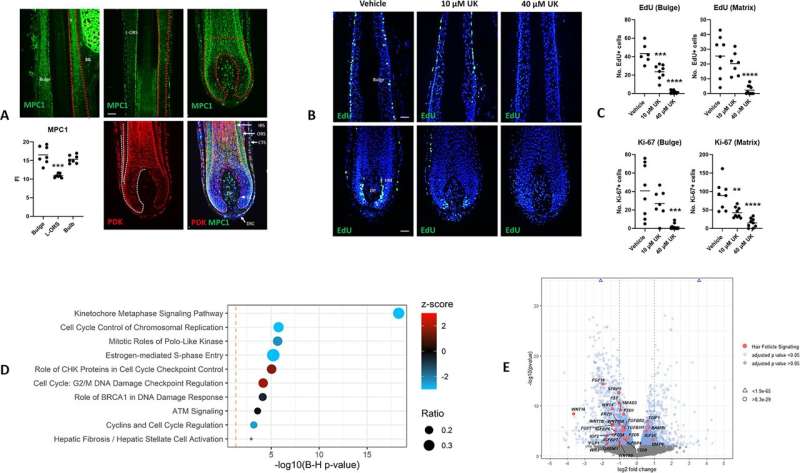This article has been reviewed according to Science X's editorial process and policies. Editors have highlighted the following attributes while ensuring the content's credibility:
fact-checked
peer-reviewed publication
trusted source
proofread
Scientists discover surprising link between ancient biology and restricted human hair growth

University of Manchester scientists have linked one of the ways that cells respond to stressful conditions with restricted healthy hair growth.
The Manchester Hair Research Group team unexpectedly discovered the link in a lab experiment where they were testing a drug to see if it would cultivate human scalp hair follicles in a dish. The study inadvertently led to a link to the cellular stress response—an ancient biological mechanism that occurs across life from yeast and roundworms through to humans.
The study is published in PLOS ONE.
The team hopes that their work in targeting the pathway might one day lead to treatments for hair loss.
Known in full as the Integrated Stress Response (ISR), it is triggered in stressful cellular conditions such as poor nutrient availability, viral infection, or when there is a buildup of misshapen proteins in cells. The ISR allows cells to put a brake on regular activities by making fewer new proteins, entering a partial stasis to adapt and deal with the stress. However, if it doesn't work, it can cause cells to die.
ISR is already the subject of great interest to scientists studying cancer, neurodegenerative disorders and aging.
Dr. Talveen Purba, Research Fellow at The University of Manchester and senior author of the study, said, "We were testing a drug that targets metabolism in human hair follicles to influence how cells generate energy, which—based on the work of others—we expected to stimulate stem cells. However, we found the opposite was true: Hair growth was instead blocked, as cells, including stem cells, quickly stopped dividing."
They also found signs that mitochondria were dysfunctional, and there were disruptions in how cells communicate with each other. Using a combination of experimental approaches to look more closely, the team found signs that ISR activation was to blame.
Derek Pye, chief technician of the research group and co-author of the study, said, "When we look at hair follicles under the microscope, it's striking how consistent the response is between hair follicles from different people."
Following on from this early-stage research, the team is now looking to better understand the broader implications of the ISR in hair follicles, and examine its activity in people with hair loss conditions.
Dr. Purba added, "We're incredibly hopeful as we believe the activation of this pathway could play an important biological role in restricting hair growth in people with hair loss conditions, meaning that targeting it could lead to new treatments."
More information: Derek Pye et al, Activation of the integrated stress response in human hair follicles, PLOS ONE (2024). DOI: 10.1371/journal.pone.0303742
Journal information: PLoS ONE
Provided by University of Manchester





















